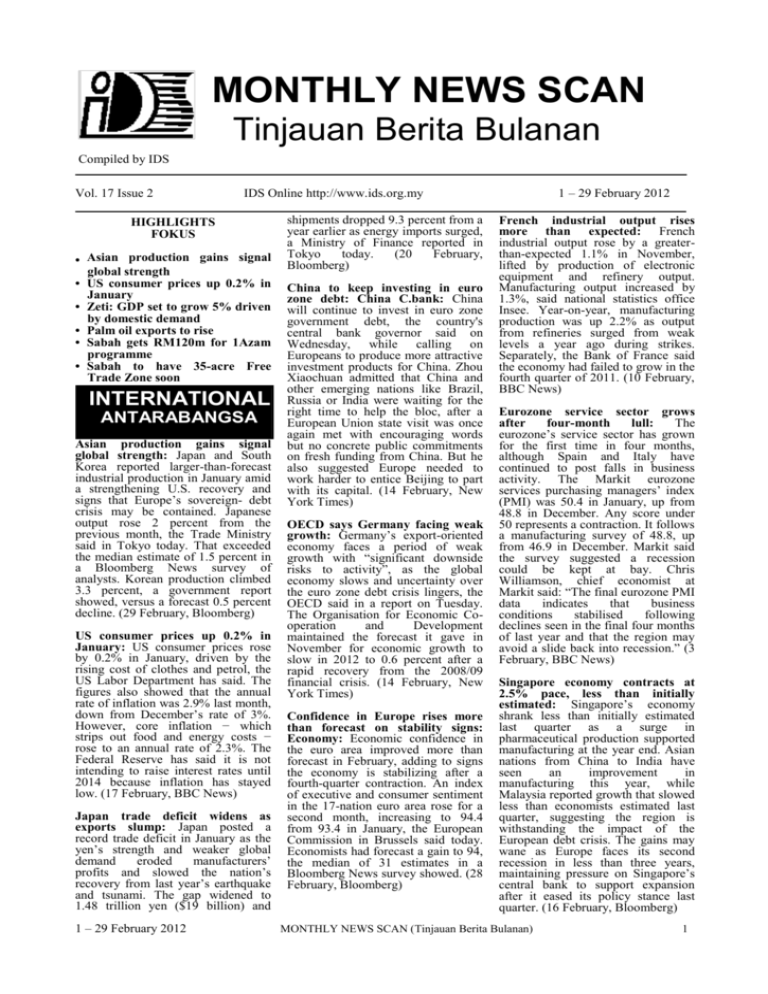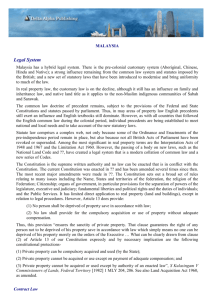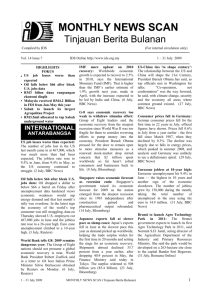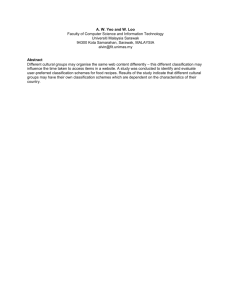Vol 17, Issue 2, Feb 2012
advertisement

MONTHLY NEWS SCAN Tinjauan Berita Bulanan Compiled by IDS Vol. 17 Issue 2 HIGHLIGHTS FOKUS • Asian production gains signal global strength • US consumer prices up 0.2% in January • Zeti: GDP set to grow 5% driven by domestic demand • Palm oil exports to rise • Sabah gets RM120m for 1Azam programme • Sabah to have 35-acre Free Trade Zone soon INTERNATIONAL ANTARABANGSA Asian production gains signal global strength: Japan and South Korea reported larger-than-forecast industrial production in January amid a strengthening U.S. recovery and signs that Europe’s sovereign- debt crisis may be contained. Japanese output rose 2 percent from the previous month, the Trade Ministry said in Tokyo today. That exceeded the median estimate of 1.5 percent in a Bloomberg News survey of analysts. Korean production climbed 3.3 percent, a government report showed, versus a forecast 0.5 percent decline. (29 February, Bloomberg) US consumer prices up 0.2% in January: US consumer prices rose by 0.2% in January, driven by the rising cost of clothes and petrol, the US Labor Department has said. The figures also showed that the annual rate of inflation was 2.9% last month, down from December’s rate of 3%. However, core inflation − which strips out food and energy costs − rose to an annual rate of 2.3%. The Federal Reserve has said it is not intending to raise interest rates until 2014 because inflation has stayed low. (17 February, BBC News) Japan trade deficit widens as exports slump: Japan posted a record trade deficit in January as the yen’s strength and weaker global demand eroded manufacturers’ profits and slowed the nation’s recovery from last year’s earthquake and tsunami. The gap widened to 1.48 trillion yen ($19 billion) and 1 – 29 February 2012 1 – 29 February 2012 IDS Online http://www.ids.org.my shipments dropped 9.3 percent from a year earlier as energy imports surged, a Ministry of Finance reported in Tokyo today. (20 February, Bloomberg) China to keep investing in euro zone debt: China C.bank: China will continue to invest in euro zone government debt, the country's central bank governor said on Wednesday, while calling on Europeans to produce more attractive investment products for China. Zhou Xiaochuan admitted that China and other emerging nations like Brazil, Russia or India were waiting for the right time to help the bloc, after a European Union state visit was once again met with encouraging words but no concrete public commitments on fresh funding from China. But he also suggested Europe needed to work harder to entice Beijing to part with its capital. (14 February, New York Times) OECD says Germany facing weak growth: Germany’s export-oriented economy faces a period of weak growth with “significant downside risks to activity”, as the global economy slows and uncertainty over the euro zone debt crisis lingers, the OECD said in a report on Tuesday. The Organisation for Economic Cooperation and Development maintained the forecast it gave in November for economic growth to slow in 2012 to 0.6 percent after a rapid recovery from the 2008/09 financial crisis. (14 February, New York Times) Confidence in Europe rises more than forecast on stability signs: Economy: Economic confidence in the euro area improved more than forecast in February, adding to signs the economy is stabilizing after a fourth-quarter contraction. An index of executive and consumer sentiment in the 17-nation euro area rose for a second month, increasing to 94.4 from 93.4 in January, the European Commission in Brussels said today. Economists had forecast a gain to 94, the median of 31 estimates in a Bloomberg News survey showed. (28 February, Bloomberg) French industrial output rises more than expected: French industrial output rose by a greaterthan-expected 1.1% in November, lifted by production of electronic equipment and refinery output. Manufacturing output increased by 1.3%, said national statistics office Insee. Year-on-year, manufacturing production was up 2.2% as output from refineries surged from weak levels a year ago during strikes. Separately, the Bank of France said the economy had failed to grow in the fourth quarter of 2011. (10 February, BBC News) Eurozone service sector grows after four-month lull: The eurozone’s service sector has grown for the first time in four months, although Spain and Italy have continued to post falls in business activity. The Markit eurozone services purchasing managers’ index (PMI) was 50.4 in January, up from 48.8 in December. Any score under 50 represents a contraction. It follows a manufacturing survey of 48.8, up from 46.9 in December. Markit said the survey suggested a recession could be kept at bay. Chris Williamson, chief economist at Markit said: “The final eurozone PMI data indicates that business conditions stabilised following declines seen in the final four months of last year and that the region may avoid a slide back into recession.” (3 February, BBC News) Singapore economy contracts at 2.5% pace, less than initially estimated: Singapore’s economy shrank less than initially estimated last quarter as a surge in pharmaceutical production supported manufacturing at the year end. Asian nations from China to India have seen an improvement in manufacturing this year, while Malaysia reported growth that slowed less than economists estimated last quarter, suggesting the region is withstanding the impact of the European debt crisis. The gains may wane as Europe faces its second recession in less than three years, maintaining pressure on Singapore’s central bank to support expansion after it eased its policy stance last quarter. (16 February, Bloomberg) MONTHLY NEWS SCAN (Tinjauan Berita Bulanan) 1 NATIONAL NASIONAL Zeti: GDP set to grow 5% driven by domestic demand: Despite the gloomy projections, Bank Negara is confident that the economy will notch a decent 5% growth this year. “We can say with a high degree of confidence that domestic demand is on a solid and steady growth,” said governor Tan Sri Dr Zeti Akhtar Aziz in an interview over BFM radio yesterday, pointing out that consumption demand and private investment activity were growing in excess of 6%. In fact, domestic demand has been the main driver of growth for the past two to three years. No doubt, the country’s exports will be affected by the slowing demand in the United States, Europe and other parts of the world. (28 February, The Star) Palm oil exports to rise: Palm oil exports from Malaysia, the world’s second largest producer, may climb as much as 10% this year, expanding faster than local output and helping to drive down stockpiles and support prices, an industry group forecast. Exports may climb to a record 19.8 million tonnes from last year’s 18 million tonnes as demand in India and China gained, Malaysian Palm Oil Council chairman Lee Yeow Chor, said in an interview. The price may advance 3.9% to RM3,300 per tonne in 2012, according to Lee. (17 February, The Star) Malaysia’s economy probably cooled: Malaysia’s economic growth probably cooled as the European debt crisis hurt exports, dragging full-year expansion to the slowest and putting pressure on the central bank to keep interest rates low. Gross domestic product (GDP) rose 4.8% in the three months through December from a year earlier, compared with 5.8% in the previous quarter, according to the median of 20 estimates in a Bloomberg survey. Malaysia’s economy probably grew 5% in 2011, down from 7.2% the previous year, a survey of 18 economists showed. The slowest growth since an economic contraction in 2009 may prompt Malaysia to keep borrowing costs low, as South-East Asian policy makers from Thailand to the Philippines lower rates to buffer their economies against weakening global demand. (15 February, The Star) 1 – 29 February 2012 Malaysian exports to pick up in the second half: Malaysian exports are likely to see a lift in growth in the second half of the year, said the national trade promotion agency Malaysia External Trade Development Corp (Matrade). Improvements can be expected from May onwards as the first quarter is seasonally a quieter period. Despite the global economic situation last year, Malaysia’s merchandise trade grew and Malaysia chalked a stellar RM1.23 trillion total trade − highest ever recorded. Like 2011, Matrade chief executive officer Dr Wong Sai Lum expects Asia to provide the bulk of the trade volume, although she is encouraged by the economic recovery in the US. With developments in the global scenario, Matrade has projected merchandise exports to grow by between five and six per cent and services to expand by 4.9 percent. (27 February, Business Times) January CPI up 2.7%, change in interest rate seen unlikely: Judging from how consumer prices moved early this year, the chances of interest rates being lowered seem remote. January’s inflation as measured by the consumer price index rose 2.7% compared with a year ago due to increases in the prices of food and non-alcoholic beverages with the rate of inflation as low as a year ago. The year-on-year increase was in line with the median estimates in a Bloomberg survey of economists and showed a further moderation in overall inflation after a 3% rise in December. (23 February, The Star) MITI formulates new approach to face uncertain global economy: The Ministry of International Trade and Industry (MITI)is formulating a new approach in the trade and industry sector to avoid Malaysia being impacted adversely by the uncertain global economic conditions at present. Its Minister, Datuk Seri Mustapa Mohamed said for this year, Malaysia needs to have a new initiative to ensure the economy can expand at a rate of between five-six percent. He said his ministry has had a number of meetings, among which was to encourage more investments in the country, particularly, small and medium enterprises (SMEs). (10 February, The Star) despite exports dipping 0.25 per cent to US$23.694 billion between January and November last year. Despite the slight drop in exports during the 11-month period, Malaysia remained the 18th largest import source for the United States, according to latest statistics released by the United States administration. The Malaysian External Trade Development Corporation (MATRADE) Commissioner in New York, Mohd Mustafa Abd Aziz, told Bernama that US-Malaysia two-way trade in 2011 was expected to stabilise with no drastic change. (10 February, The Star) December IPI up 3%, boosted by higher manufacturing and electricity output: The Industrial Production Index (IPI) in December 2011 increased 3% year-on-year due to the increase of manufacturing and electricity indices of 4.5% and 3.1% respectively. However, the index of mining posted a marginal decrease of 0.8%,” the Department of Statistics said on its website today. Meanwhile, the IPI in November 2011 was revised to 2.4% year-on-year. “The IPI increased 3.5% month-on-month in December 2011. The index for the year of 2011 increased 1.4% as against the year of 2010,” it said. On year-on-year basis, the manufacturing output in December 2011 ascended by 4.5%. Output for November 2011 expanded by 5% (revised) from the same month of 2010. (9 February, The Star) Pujian IMF buktikan pengurusan kewangan Malaysia mantap: Gambaran positif yang diberikan Tabung Kewangan Antarabangsa (IMF) bahawa sistem kewangan Malaysia adalah mantap dan berdaya tahan serta berada pada kedudukan yang baik untuk menghadapi persekitaran luar yang mencabar, mengesahkan bahawa pengurusan kewangan negara dijalankan dengan baik. Pujian harus diberi kepada Bank Negara Malaysia dan pentadbiran Perdana Menteri Datuk Seri Najib Tun Razak yang arif mengenai pengurusan kewangan berkenaan, hasil daripada kawalan ketat yang dikenakan terhadap bankbank dalam menjalankan operasi mereka dan mengekalkan daya tahan ekonomi negara. (18 Februari, Utusan Malaysia) M’sia Asean’s leading exporter to US: Malaysia remained Asean’s leading exporter to the United States MONTHLY NEWS SCAN (Tinjauan Berita Bulanan) 2 LOCAL TEMPATAN Sabah gets RM120m for 1Azam programme: A sum of RM120 million had been allocated under the Program Akhiri Zaman Miskin (1Azam) to eradicate poverty in Sabah. Deputy Chief Minister Datuk Yahya Hussin said the allocation from the federal government was for two phases of the programme, with the first phase implemented in 2010 involving RM40 million and the second in 2011 involving RM80 million. He said 12,500 households earning less than RM950 monthly (poor) and less than RM550 (hardcore poor) were targeted under the programme. (8 February, New Sabah Times) Sabah to have 35-acre Free Trade Zone soon: A 35-acre Free Trade Zone along the lines of that at Stulang, in Johor Baru − currently the largest duty-free complex in Malaysia which includes hotels, restaurants, entertainment outlets and a shopping complex − has been planned for Tanjung Batu in Tawau. State Customs Director Dr Janatan Kandok said the move is at the planning stage and had been agreed to, in principle, by the relevant authorities to attract tourists and enhance economic activities in the locality. A Free Trade Zone is a facility to stimulate business and economic activities in a certain area that has been approved for the people, including tourists, to enjoy products and services free from taxes. (16 February, Daily Express) Rural Ministry allocates RM41mil for infrastructure projects in Kunak: The Rural and Regional Development Ministry has allocated RM41mil for basic infrastructure projects including water, electricity and roads in Kunak district. Minister Datuk Seri Mohd Shafie Apdal said most of the projects were under construction, some had been completed and nearing completion while others were still at planning stage. “These projects have been implemented since last year and construction will continue,” he told reporters after attending the Pemimpin Bersama Rakyat programme and visiting project sites here in Kunak yesterday. (7 February, New Sabah Times) POIC Lahad Datu’s success indicates state and fed govt on 1 – 29 February 2012 right track: The Palm Oil Industrial Cluster (POIC) in Lahad Datu, which opened six years ago, has attracted RM3 billion in investments so far from both foreign and local investors. For Sabah’s Industrial Development Minister, Datuk Raymond Tan Shu Kiah, the investments are an indication that the state government, assisted by the federal government, have set upon the right track with their efforts to develop the area. A total of 30 foreign investors including from Europe, Singapore, South Korea and Japan as well as investors from Kuala Lumpur have made their investments there. The investors from Kuala Lumpur include those involved in biodiesel and fertilizers based operations. (16 February, The Star) SESB: 174 villages in Sabah will be provided with power supply: Another 174 villages in Sabah will be provided with power supply this year under the Rural and Regional Development Ministry’s rural electrification programme. From 2009 until 2011, nearly 900 identified villages in Sabah had been provided with 24-hour power supply under the Ministry’s rural electrification programme. Almost RM1.6 billion had been allocated by the Ministry to implement the programme in Sabah during the period, said Ahmad Sazree Abd Aziz, general manager (distribution) of Sabah Electricity Board (SESB) in a statement yesterday. He said Kampung Long Mio in Sipitang had been identified as one of the villages which would be provided with power supply. (2 February, New Sabah Times) Projek bina, lebar jalan raya di Tawau akan dilaksanakan: Beberapa projek pelebaran jalan raya dan pembinaan jalan baru akan dilaksanakan di daerah ini bagi mengatasi masalah kesesakan pada waktu puncak, sekaligus untuk mempertingkatkan tahap ekonomi daerah. Menteri Pembangunan Infrastruktur Negeri Tan Sri Joseph Pairin Kitingan berkata, antara projek yang kini giat dirancang ialah pembinaan Jalan Pintas Tawau dari kawasan Pasir Putih ke Jalan Apas bernilai RM260 juta. Perancangan projek pembinaan jalan raya sepanjang 20 kilometer itu ujarnya kini berada di peringkat akhir dan kemudahan itu akan menjadi penghubung alternatif untuk pengguna jalan raya di daerah ini. (1 Februari, New Sabah Times) Program Tukar bolehkan koperasi jana pulangan RM4.3 juta: Pelaksanaan skim Projek Transformasi Kedai Runcit (Tukar) di Sabah membolehkan 30 koperasi di negeri ini menjana pulangan jualan sebanyak RM4.3 juta pada tahun lalu. Timbalan Ketua Menteri, Datuk Yahya Hussin berkata, ini membuktikan pelaksanaan program itu berjaya membantu koperasi meningkatkan pusingan perniagaan serta gerakan koperasi. “Jadi saya berharap lebih banyak lagi koperasi akan terlibat dalam program ini pada masa akan datang kerana terbukti mampu memberikan keuntungan. “Malah, pada tahun ini sebanyak 20 kedai koperasi akan terlibat dengan program ini,” katanya pada majlis perasmian Karnival Jualan dan Ekspo Koperasi di Kota Kinabalu hari ini. (27 Februari, Utusan Malaysia) Projek Ammonia Urea Sabah bawa rahmat: Apa yang boleh disimpulkan oleh Ahli Parlimen Sipitang, Datuk Sapawi Ahmad mengenai Projek Ammonia Urea Sabah (Samur) adalah sebagai pembawa rahmat besar buat pembangunan di daerah Sipitang. Bagi pemimpin No. 1 di daerah tersebut, Samur diibaratkan sebagai limpahan rezeki khususnya buat penduduk Sipitang dan daerah berdekatan seperti Tenom dan Beaufort. Katanya, ia bukan sahaja bakal meletakkan Sipitang di persada dunia sebagai pengeluar baja urea kedua terbesar di Asia Tenggara, projek yang dijangka beroperasi pada 2015 itu juga bakal memberi manfaat besar kepada pembangunan Sabah. (24 Februari, Utusan Malaysia) RM5.2 juta jayakan fasa kedua Azam Tani: Sebanyak RM5.2 juta diperuntukkan kepada Kementerian Pertanian dan Industri Makanan tahun ini bagi melaksanakan fasa kedua program Akhiri Zaman Miskin (1Azam). Timbalan Ketua Menteri, Datuk Seri Yahya Hussin berkata, seramai 460 ketua isi rumah disasarkan mendapat manfaat daripada pelaksanaan program itu. “Ia melibatkan tujuh program iaitu pemprosesan makanan, pengeluaran tanaman singkat masa, kursus operator pembajak sawah, program traktor dua roda, program mesin penuai padi, program kisaran padi dan perkhidmatan menabur benih serta baja,” katanya. Beliau yang juga Menteri Pertanian dan Industri Makanan negeri berkata demikian pada majlis penutupan kursus motivasi dan asas pengurusan perniagaan Program 1Azam (Azam Tani) di Kota Kinabalu hari ini. (25 Februari, Utusan Malaysia) MONTHLY NEWS SCAN (Tinjauan Berita Bulanan) 3 SELECTED FACTS AND FIGURES FAKTA MUTAKHIR MALAYSIA: SELECTED ECONOMIC AND FINANCIAL INDICATORS 2007 Growth (% change) Real GDP Total domestic demand Consumption Private consumption Gross capital formation Saving and investment (% GDP) Gross domestic investment Gross national saving Fiscal sector (% GDP) Federal government overall balance Revenue Expenditure and net lending CPI inflation 2008 2009 Proj. 2011 2012 2010 6.5 9.4 9.7 10.5 8.4 - 6.5 9.4 9.7 10.5 8.4 - 6.5 9.4 9.7 10.5 8.4 - 6.5 9.4 9.7 10.5 8.4 - 6.5 9.4 9.7 10.5 8.4 - 6.5 9.4 9.7 10.5 8.4 - 3.75 3.75 3.75 3.75 3.75 3.75 -3.2 21.8 25.0 2.0 -3.2 21.8 25.0 2.0 -3.2 21.8 25.0 2.0 -3.2 21.8 25.0 2.0 -3.2 21.8 25.0 2.0 -3.2 21.8 25.0 2.0 (Source: 13 February, Business Times) TRANSFORMATION & LOGISTICS MARKET SIZE (RM Bil.) e: estimate (Source: 7 February, Business Times) PRODUCTION PRICE INDEX, MALAYSIA (2005=100) Index Percentage change Producer Price Index Domestic Economy Local Production Import Jan 2011 Dec 2011 Jan 2012 Dec 2011-Jan 2012 Jan 2011-Jan 2012 123.8 129.9 111.6 129.2 137.2 113.2 128.9 136.7 113.5 -0.2 -0.4 0.3 4.1 5.2 1.7 MONTHLY NEWS SCAN (Tinjauan Berita Bulanan) 4 (Source: 29 February, Department of Statistic Malaysia) 1 – 29 February 2012 SEKTOR PERDAGANGAN EDARAN – NILAI JUALAN (RM Bil.) (Source: 13 February, Department of Statistics Malaysia) PRESTASI SEKTOR PERDAGANGAN EDARAN SUKU KEEMPAT 2011 Nilai jualan Sektor Guna tenaga % perubahan % perubahan YoY QoQ 0.6 0.1 Perdagangan edaran YoY 15.7 QoQ 1.5 Perdagangan borong 19.8 2.6 -0.2 0.3 Perdagangan runcit 13.0 1.5 1.6 -0.2 Kenderaan bermotor 8.2 -2.6 -1.9 0.7 (Source: 13 February, Department of Statistic Malaysia) PERFORMANCE OF ASIAN MARKETS ON FEBRUARY 14 (%) (Source: 15 February, The Star) 1 – 29 February 2012 MONTHLY NEWS SCAN (Tinjauan Berita Bulanan) 5









